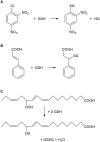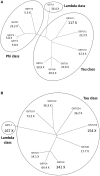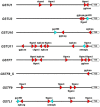Glutathione S-Transferase Enzymes in Plant-Pathogen Interactions
- PMID: 30622544
- PMCID: PMC6308375
- DOI: 10.3389/fpls.2018.01836
Glutathione S-Transferase Enzymes in Plant-Pathogen Interactions
Abstract
Plant glutathione S-transferases (GSTs) are ubiquitous and multifunctional enzymes encoded by large gene families. A characteristic feature of GST genes is their high inducibility by a wide range of stress conditions including biotic stress. Early studies on the role of GSTs in plant biotic stress showed that certain GST genes are specifically up-regulated by microbial infections. Later numerous transcriptome-wide investigations proved that distinct groups of GSTs are markedly induced in the early phase of bacterial, fungal and viral infections. Proteomic investigations also confirmed the accumulation of multiple GST proteins in infected plants. Furthermore, functional studies revealed that overexpression or silencing of specific GSTs can markedly modify disease symptoms and also pathogen multiplication rates. However, very limited information is available about the exact metabolic functions of disease-induced GST isoenzymes and about their endogenous substrates. The already recognized roles of GSTs are the detoxification of toxic substances by their conjugation with glutathione, the attenuation of oxidative stress and the participation in hormone transport. Some GSTs display glutathione peroxidase activity and these GSTs can detoxify toxic lipid hydroperoxides that accumulate during infections. GSTs can also possess ligandin functions and participate in the intracellular transport of auxins. Notably, the expression of multiple GSTs is massively activated by salicylic acid and some GST enzymes were demonstrated to be receptor proteins of salicylic acid. Furthermore, induction of GST genes or elevated GST activities have often been observed in plants treated with beneficial microbes (bacteria and fungi) that induce a systemic resistance response (ISR) to subsequent pathogen infections. Further research is needed to reveal the exact metabolic functions of GST isoenzymes in infected plants and to understand their contribution to disease resistance.
Keywords: WRKY; bacterium; fungus; glutathione S-transferase; oxidative stress; plant pathogen; salicylic acid; virus.
Figures



Similar articles
-
Regulatory and functional interactions of plant growth regulators and plant glutathione S-transferases (GSTs).Vitam Horm. 2005;72:155-202. doi: 10.1016/S0083-6729(05)72005-7. Vitam Horm. 2005. PMID: 16492471 Review.
-
Glutathione transferase supergene family in tomato: Salt stress-regulated expression of representative genes from distinct GST classes in plants primed with salicylic acid.Plant Physiol Biochem. 2014 May;78:15-26. doi: 10.1016/j.plaphy.2014.02.010. Epub 2014 Feb 19. Plant Physiol Biochem. 2014. PMID: 24607575
-
Unraveling the involvement of WRKY TFs in regulating plant disease defense signaling.Planta. 2023 Nov 28;259(1):7. doi: 10.1007/s00425-023-04269-y. Planta. 2023. PMID: 38012461 Review.
-
Glutathione Transferase Photoaffinity Labeling Displays GST Induction by Safeners and Pathogen Infection.Plant Cell Physiol. 2024 Jan 19;65(1):128-141. doi: 10.1093/pcp/pcad132. Plant Cell Physiol. 2024. PMID: 37924215 Free PMC article.
-
The Arabidopsis glutathione transferase gene family displays complex stress regulation and co-silencing multiple genes results in altered metabolic sensitivity to oxidative stress.Plant J. 2009 Apr;58(1):53-68. doi: 10.1111/j.1365-313X.2008.03761.x. Epub 2009 Jan 19. Plant J. 2009. PMID: 19067976
Cited by
-
Differential Strategies of Ectomycorrhizal Development between Suillus luteus and Pinus massoniana in Response to Nutrient Changes.J Fungi (Basel). 2024 Aug 19;10(8):587. doi: 10.3390/jof10080587. J Fungi (Basel). 2024. PMID: 39194913 Free PMC article.
-
Complex relationship between DNA methylation and gene expression due to Lr28 in wheat-leaf rust pathosystem.Mol Biol Rep. 2020 Feb;47(2):1339-1360. doi: 10.1007/s11033-019-05236-1. Epub 2019 Dec 23. Mol Biol Rep. 2020. PMID: 31873872
-
Genome-wide identification and characterization of Fusarium circinatum-responsive lncRNAs in Pinus radiata.BMC Genomics. 2022 Mar 10;23(1):194. doi: 10.1186/s12864-022-08408-9. BMC Genomics. 2022. PMID: 35264109 Free PMC article.
-
Transcriptional Changes on Blight Fruiting Body of Flammulina velutipes Caused by Two New Bacterial Pathogens.Front Microbiol. 2019 Dec 11;10:2845. doi: 10.3389/fmicb.2019.02845. eCollection 2019. Front Microbiol. 2019. PMID: 31921028 Free PMC article.
-
Application of Data-Independent Acquisition Approach to Study the Proteome Change from Early to Later Phases of Tomato Pathogenesis Responses.Int J Mol Sci. 2019 Feb 17;20(4):863. doi: 10.3390/ijms20040863. Int J Mol Sci. 2019. PMID: 30781546 Free PMC article.
References
-
- Agisha V. N., Eapen S. J., Monica V., Sheoran N., Munjal V., Suseelabhai R., et al. (2017). Plant endophytic Pseudomonas putida BP25 induces expression of defense genes in black pepper roots: deciphering through suppression subtractive hybridization analysis. Physiol. Mol. Plant Pathol. 100, 106–116. 10.1016/j.pmpp.2017.07.006 - DOI
-
- Ahn S. Y., Kim S. A., Yun H. K. (2016). Glutathione S-transferase genes differently expressed by pathogen-infection in Vitis flexuosa. Plant Breed. Biotech. 4, 61–70. 10.9787/PBB.2016.4.1.61 - DOI
Publication types
LinkOut - more resources
Full Text Sources
Other Literature Sources
Research Materials

